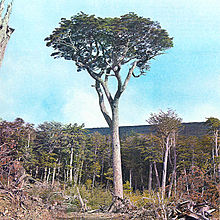|
Nothofagus betuloides
Nothofagus betuloides, Magellan's beech[1] or guindo, is a tree native to southern Patagonia. In 1769, Sir Joseph Banks collected a specimen of the tree in Tierra del Fuego during Captain Cook's first voyage.[3] Its occurrence on Hornos Island earns it the distinction of being the southernmost tree on Earth.[4] DistributionNothofagus betuloides grows from southern Chile and southern Argentina (40°S) to Tierra del Fuego (56°S). It is found from sea level to 500 m (1,600 ft) above mean sea level. One specimen growing near the southeastern corner of Hornos Island (Cape Horn) was identified in 2019 as the southernmost tree in the world.[4] DescriptionIt is an evergreen tree up to 30 m (98 ft) tall, with a branching reaching appearance. In its natural Patagonian environment, it tolerates cold winters and thrives in the absence of heat, but it is not tolerant of persistent freezing. In the exposed sites of its southerly coastal or Andean distribution, the species grows as a wind formed shrub. CultivationNothofagus betuloides has been cultivated in Scotland and the Faroe Islands, and has grown well there. Trees planted in the Faroe Islands, which were imported directly from its southernmost distribution in Tierra del Fuego, have turned out to be very hardy.[5] The wood has beautiful marks, and is pinkish, hard, and semiheavy; it is used in furniture and construction.
References
|
||||||||||||||||||||||||||||||||||||||



